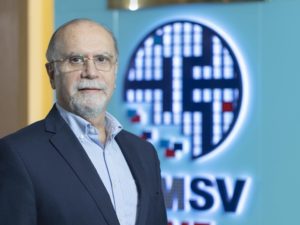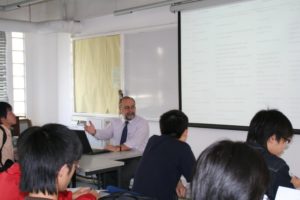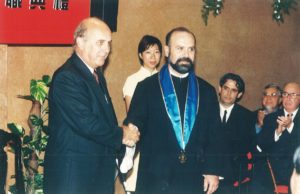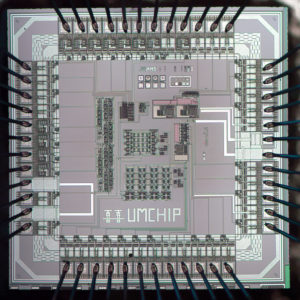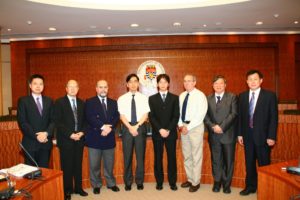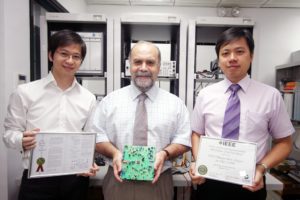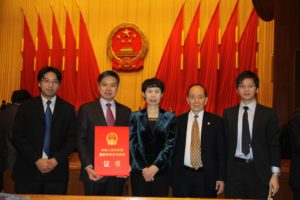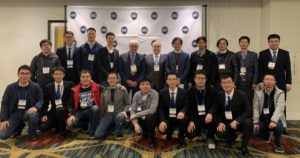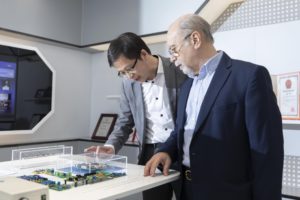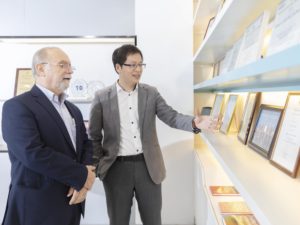29 years ago, a Portuguese professor of microelectronics travelled from Europe to Macao, a city with a blend of Chinese and southern European vibe. When he arrived at the University of Macau (UM) campus as a visiting professor, he was planning to return to Portugal in two years. However, inspired by a group of diligent and talented students, he finally chose to stay at UM, where he has since led generations of students to promote microelectronics research. Today, he and his students have established a world-leading state key laboratory of microelectronics at UM, and together they have developed a series of advanced chips in Macao, which was once derided as a ‘research desert’.
A Research Blueprint for Two Decades
The exhibition room of the State Key Laboratory of Analog and Mixed-Signal VLSI (SKL-AMSV) showcases UM’s achievements in microelectronics research, with photos of chips developed by UM researchers and their participation in international academic conferences decorating the walls. Some of these photos depict important moments of the academic journey of Prof Martins, who is UM’s vice rector for global affairs, and director of the university’s Institute of Microelectronics and the SKL-AMSV.
On the evening of 29 October 1992, Prof Martins, his wife, and their three children walked into the staff quarters of the old UM campus, which was located on Taipa Island. ‘To be honest, my first impression of UM was not very good,’ says Prof Martins. ‘I told my wife not to unpack all of our bags because I thought we would probably be going back to Portugal soon.’
Before joining UM, Prof Martins had taught electrical engineering at the Instituto Superior Técnico of the University of Lisbon in Portugal for 12 years. In 1983, he designed a chip with analogue functions. In 1991, he became the first in Portugal to design a chip for a doctoral thesis.
When Prof Martins arrived at UM in 1992, the semester was coming to an end and there were no classes to teach. Accustomed to a busy schedule, he set himself a task: writing a report on the Faculty of Science and Technology (FST). ‘I was only 35. Today, almost 30 years later, I have over 700 publications, but I still think the best thing I’ve written is this report,’ he says.
In his report, he proposed new areas of research at UM and launching master’s and doctoral programmes. His suggestions were approved by the Portuguese Macao government and Prof Li Tianqing, then rector of UM. The report became his blueprint for promoting research at UM over the next two decades, with him as dean of the FST (1994-1997) and vice rector for research (1997-2018). In the report, he also pointed out that the students at UM were highly motivated to learn, unlike the students he had taught in Portugal. ‘I came to Macao on a two-year contract as a visiting professor, but these hard-working students made me want to stay at UM,’ he says.
The First Microelectronic Chip Designed by UM
Prof Martins was instrumental in launching the first batch of FST’s master’s programmes in 1993, including his own master’s programme in electrical and electronics engineering. He recalls: ‘In the UM Senate, a professor was totally against this master’s programme. He said it was impossible to do electronics research in Macao. He believed that only big companies like IBM and Intel could do it.’
The professor’s pessimism was not unexpected, as Macao was then considered a ‘research desert’. Even the first ten students in the master’s programme didn’t believe they would be successful when they began designing chips. ‘It was very difficult, because the students didn’t know anything about the technology,’ says Prof Martins. ‘The computers here weren’t very good for designing chips either. And we didn’t have a lot of computers. To meet their goals on time, the students had to work at night and the Chinese New Year holidays.’ With scarce resources, however, they successfully developed the first generation of UM chip, in 1994. This first UM-designed chip was presented at an academic conference in 1995.
After the development of the first generation of UM Chip, Prof Martins was excited to create a microelectronics research team. The first step was to recruit students as teaching assistants. In 1997, the first doctoral programme in electrical and electronic engineering was launched, with Ben U and Ken Tam as the first two students. In 2002, Prof Tam founded the Wireless Communication Laboratory at UM, which was followed by the creation of the Analog and Mixed-Signal VLSI Laboratory by Prof Martins and Prof Ben U in 2003.
Distinguishing Itself with Chip Research
The laboratory was initially located in a garage on the old campus, and was later moved to two small rooms on the car park floor of the Jubilee Building. At that time, the laboratory was short of funding, equipment, and working space. Fortunately, after the Macao Science and Technology Development Fund was established in 2005, the laboratory could apply for its funding for research projects, and its the scale and achievements begun to surge. In 2009, UM applied to the Ministry of Science and Technology of China for the establishment of a state key laboratory and the granting of state key lab status for Prof Martins’s existing laboratory of microelectronics. However, after visiting Fudan University in Shanghai in 2010, Prof Martins felt it was impossible for his laboratory to be approved as a state key laboratory.
At the time, China’s only state key laboratory of microelectronics was located at Fudan University. ‘We only had about 30 people. This Fudan laboratory had 300 people,’ says Prof Martins. ‘Here, we had two small rooms in a parking lot. Theirs was a huge five-storey building in Pudong. So I said we couldn’t get approval.’ However, a laboratory’s research results don’t necessarily depend on its size. In November 2010, two UM papers were selected for presentation at the International Solid-State Circuits Conference (ISSCC), which is the world’s leading forum for presenting the latest advances in chip research. At the conference, UM was ranked 15th in the world and fifth in Asia. Other presenters included the Tokyo Institute of Technology, STMicroelectronics in France, the University of California, Berkeley, Taiwan University, Chiao Tung University Toshiba, Korea Advanced Institute of Science and Technology, Texas Instruments, Broadcom, Analog Devices, and the Massachusetts Institute of Technology. One month later, the Ministry of Science and Technology approved the establishment of SKL-AMSV at UM. This affirmed the university’s leading position and international influence in microelectronics research.
In 2014, the laboratory moved to UM’s new campus on Hengqin Island in Guangdong and has grown rapidly since then. Today, it has two innovation centres and a spin-off biotech company, and also offers two master’s programmes.
From 2011 to 2021, 41 papers from the laboratory were selected for presentation at ISSCC. In the 2019 conference, UM had eight papers selected, which is equal to the number of selected papers from the mainland China and Hong Kong combined, ranked the UM second in the world, next only to Intel. ‘Two decades ago, the professor at UM said that only Intel and IBM had the capability to do microelectronics research. Today, we are at the same level as Intel,’ says Prof Martins. In other words, UM has distinguished itself internationally with outstanding results in chip research.
After completing his first chip design with his students in 1994, Prof Martins returned for 1 week to the Instituto Superior Técnico at the University of Lisbon, where a Chinese doctoral student helped him engrave the Chinese character for ‘double happiness’ on the chip, symbolising the wish for good luck to the UM research team. Prof Martins says he was indeed lucky to have made his mark in microelectronics at UM, but the main contributing factor to his success was not luck, but the support of his family and the faith his students placed in him. ‘I told the students that the University of Macau was not famous, but we could make it famous by developing microelectronics.’ He says. ‘Even I didn’t quite believe myself when I said that, but they believed me and had faith in me. Striving to be on top of the world is not easy, but with determination, our students have succeeded in doing just that. Elvis is an example.’
First UM Undergraduate to Publish in an Academic Journal
Elvis first met Prof Martins in a circuit analysis class in 1999, when he enrolled at UM after graduating from Instituto Salesiano, a Catholic school in Macao. In 2003, he wrote his graduation thesis under the supervision of Prof Ben U. Prof Martins found the topic of Mak’s thesis interesting, helped them write an academic article based on that thesis, and published it in Electronics Letters, an academic journal. ‘That was the first time that an article by an UM undergraduate student had been published in a journal. Prof Ben U and I thought Elvis could probably go straight to a PhD without taking a master’s programme,’ Prof Martins says.
Three years later, Mak received his PhD from UM. Later, he became Prof Martin’s colleague in the laboratory, of which he is now a deputy director. ‘After the students get a PhD, they don’t call me professor anymore. They call me Rui. So we’re Rui and Elvis. We are friends rather than a teacher and a student,’ says Prof Martins.
Over the past 22 years, Prof Mak has learned academic knowledge and leadership skills from his mentor. He says: ‘Prof Martins was the vice rector for research for many years. He has been trying to develop a research plan for the university over the past 20 years. I know how difficult it has been for UM to develop to what it is today. Everyone has difficulties in his position, but Prof Martins’ position was extremely difficult. He overcame all the challenges to make things happen, turning one research idea after another into concrete projects.’
Chip research has become a key research area at UM, which is now at the forefront of this field. The pioneer of Macao’s chip design is now leading a group of outstanding researchers and students. ‘It’s not easy to reach the top of the world in chip research, but when you try to do it and achieve your goals, you arrive at the top,’ says Prof Martins.
Innovation knows no boundaries, and the pioneering spirit of the UM Chips will be passed down from generation to generation at the university.
Source: My UM e-version
29年前,一位葡萄牙人因為澳門大學,從歐洲越洋來到澳門這座具有南歐特色的小城,為這裡的科研拓荒。這位拓荒者就是微電子專家馬許願教授。他踏足校園那天,計劃只訪學兩年便回葡萄牙,最後卻為一班勤奮優秀的學生留下來,自此帶領一代又一代學生推動微電子研究,在澳門這個昔日的科研荒漠建立了全球頂尖的微電子國家重點實驗室,建立了「澳門芯」的科技品牌。
一份報告寫下廿年科研藍圖
在模擬與混合信號超大規模集成電路國家重點實驗室(下簡稱實驗室),展示廳陳列了「澳門芯」歷年的重大成果和獎項,牆上掛著一張張見證芯片研發和師生參與國際研討會的照片。馬許願教授現任全球事務副校長,身兼模擬與混合信號超大規模集成電路國家重點實驗室主任、微電子研究院院長。他坐在展示廳,憶述為「澳門芯」奮鬥的科研路。
1992年10月29日晚上,馬教授帶著太太和三個孩子從葡萄牙來到澳門,走進當時位於氹仔島上澳門大學舊校園的教職員宿舍。「我對澳大的第一印像其實不太好。我當時就跟太太說,你應該不用打開所有行李袋,因為我們可能很快就回葡萄牙。」
來澳門前,馬教授是里斯本大學高等技術學院的電子學教授,有12年教研經驗。1983 年,他在葡萄牙設計出具有模擬功能的芯片,1991 年成為該國首個為博士論文設計芯片的人。
馬教授1992年抵達澳大時,發現學期已近尾聲,他沒有課要上,也沒有任何人告訴他要做甚麼。習慣忙碌的他於是給自己一個任務:寫一份分析科技學院的報告。「至今我已發表700多篇學術出版物,但通通不及這份我在35歲時寫的報告重要。」
馬教授在報告提出澳大要拓展新的科研領域、開辦碩士和博士課程,獲得澳葡政府和時任校長李天慶教授認同,這也成為他往後20多年擔任科技學院院長(1994年至1997年)和研究副校長(1997年至2018年)時在澳大推動科研的藍圖。在這份報告裏,他還強調澳大學生充滿學習動力,與他在葡萄牙見到的學生截然不同。「我最初與澳大隻簽了訪問教授合約,但這些勤奮優秀的學生令我願意留在這裏。」
首塊由澳大設計的芯片
在馬教授推動下,科技學院在1993年首次開辦碩士課程,包括他親自負責的電子及電工工程碩士課程。「在澳大教務委員會開會時,一位教授強烈反對開辦這個碩士課程,他說澳門是不可能做電機電子研究,只有Intel、IBM這些大公司才能做到。」
當時澳門是科研荒漠,那位教授的悲觀並不意外。就連該碩士課程首屆10名學生開始設計芯片時,也不相信自己會成功。馬教授說:「最初他們對芯片科技一無所知。大學的電腦也不太適合做這類工作,而且電腦也不足夠。為了準時完成芯片設計,學生在夜間,甚至農曆新年假期也回到實驗室埋頭研究。」雖然資源極度貧乏,但馬教授和學生還是在1994年研發首塊由澳大設計的芯片:第一代「UM Chip」(澳大芯),並在翌年一個學術會議發表論文。
第一代澳門芯研發後,馬教授大為振奮,開始建立微電子科研團隊,第一步就是招攬學生成為教學助理。1997年,澳大開辦首屆電機電子工程博士課程,余成斌和譚錦榮成為首兩名博士生。譚錦榮在2002年於澳大創立無線通訊實驗室。馬教授和余成斌的模擬與混合信號超大規模集成電路實驗室(下簡稱集成電路實驗室)於2003年成立。
芯片闖出名堂
集成電路實驗室最初設於舊校園一個車庫,後來搬到珍禧樓的停車場樓層的兩個小房間,缺乏資金、設備和空間。幸好澳門科學技術發展基金在2005年成立後,集成電路實驗室可以為項目申請資助,規模和成果開始顯著增加。2009年,澳大向國家科技部申請建立兩個國家重點實驗室,其中一個以集成電路實驗室為基礎。不過,馬教授在2010年到訪上海復旦大學後,對實驗室的升格不抱期望。
當時中國唯一研究集成電路的國家重點實驗室設於復旦大學,馬教授說:「我們只有約30人和兩個房間,復旦的實驗室有300人和一幢在浦東的五層大樓,所以我不相信我們會成功。」然而,實驗室規模和研究水平沒有必然關係。2010年11月,在公認代錶芯片研究最高水平的國際固態電路會議上,澳大有兩篇論文入選,於該會議上位列全球第15、亞洲第五。與澳大同場發表論文的還包括日本TIT、法國意法半導體有限公司、美國加州大學柏克萊分校、台灣大學、台灣交通大學、日本東芝、韓國KAIST、Texas Instruments、Broadcom、亞德諾以及麻省理工學院等。一個月後,國家科技部批准成立模擬與混合信號超大規模集成電路國家重點實驗室(澳門大學),肯定了澳大在微電子研究的地位和國際影響。
澳大在2014年遷入位於廣東省橫琴島的新校園後,實驗室發展迅速,目前下設兩個中心和開辦兩個碩士課程,並有一間生物科技衍生公司。
2011年至2021年間,實驗室在國際固態電路會議共有41篇論文入選。在2019年的會議,澳大有八篇論文入選,等於內地和香港所有入選論文的數量,全球排第二,僅次Intel。馬教授說:「20多年前,澳大那位教授說芯片研究只有Intel等公司做到,今日我們已達到Intel的水平了。」
1994年,馬教授在與學生完成首塊芯片的設計後,隨即回到里斯本大學高等技術學院一星期,在那裏刻製芯片,當時該學院一位華人博士生幫他刻了一個「囍」字在芯片上,希望為澳大的研發團隊帶來好運。他說,在澳大研究微電子有所成就,確實是他的幸運,但最大的原因是家人的支持和學生的信任。「最初我跟學生們說,澳大不太有名,但我們的微電子研究可以為澳大闖出名堂!當時其實我心裏也不太相信自己,但學生相信了我。做出世界頂尖的芯片絕非易事,但他們做到了,Elvis就是其中一人。」
澳大首位在發表期刊論文的本科生
1999年,麥沛然(Elvis)在慈幼中學畢業後入讀澳大,在一門電路分析課上第一次見到馬教授。2003年,他在余成斌教授指導下撰寫畢業論文。馬許願認為題目非常有趣,於是協助他們以該論文為基礎撰寫一篇文章投稿,獲學術期刊《Electronics Letters》刊登。馬教授說:「那是澳大第一次有本科生的論文獲學術期刊刊登,我與余成斌教授都認為Elvis可以直接攻讀博士學位。」
三年後,麥沛然博士畢業,正式成為馬教授在實驗室的同事,目前是實驗室的(研究)副主任。馬教授說:「每個學生完成博士學位後,都不再叫我教授,而是稱呼我的葡文名Rui,所以我們是Rui和Elvis,是朋友而不是師徒。」
過去22年,麥沛然從亦師亦友的馬教授身上先是學習學術知識,後來學習領導能力。麥沛然說:「Rui曾經長期負責研究事務,參與建立大學過去20多年的研究發展計劃。我們都知道,澳大發展到今日的水平非常艱鉅,每個澳大人都面對了不少挑戰,Rui的任務尤其繁重。但他克服了一切困難,使一個又一個研究想法成真。」
澳大的芯片已經達到世界先進水平,是大學的主要研究方向之一。當年的拓荒者,今天已經桃李滿門、碩果纍纍。馬教授說:「在芯片研究領域要達到世界最頂尖水平並非容易,但當你嘗試去做並實現目標時,你就到達了最高峰。」
開拓創新,永無止境!澳大芯的拓荒者精神將會繼續在澳大一代一代地延續下去……
來源:《澳大人》電子版
Prof Rui Martins says UM can make a name for itself with microelectronics research
馬許願教授表示,微電子研究可以為澳大闖出名堂
Prof Martins chose to stay at UM for his hardworking and talented students
馬許願教授選擇留在澳大,最大的原因是有一班勤奮優秀的學生
Prof Martins (right) became the vice rector of UM in 1997, the same year the university launched its first doctoral programme in electrical and electronic engineering
馬許願教授(右)在1997年就任澳大副校長,同年大學開辦首屆電機電子工程博士課程
The first generation of UM chip has the Chinese character for ‘double happiness’ ‘囍’ engraved on it
第一代澳大芯上面刻有一個「囍」字
In 2006, Prof Rui Martins invited leading experts in microelectronics
to be part of the evaluation panel for Elvis Mak’s PhD oral defense
2006年馬許願教授(左三)邀請頂尖的微電子專家擔任麥沛然(右四)博士論文的答辯評審委員
In 2009, Prof Rui Martins (middle), Prof Ben U (right), and
Prof Elvis Mak are awarded Macao’s first US patent in microelectronics
2009年,馬許願教授(中)、余成斌教授(右)和麥沛然教授獲得澳門院校在微電子領域的首個美國專利
In 2011, the State Key Laboratory of Analog and Mixed-Signal VLSI (University of Macau)
receives Macao’s first Second Prize of the State Scientific and Technological Progress Award
2011年,模擬與混合信號超大規模集成電路國家重點實驗室(澳門大學)獲得澳門首個國家科技進步二等獎
A group photo of Prof Rui Martins (2nd row, 6th from left) and his research team
after presenting an article at the International Solid-State Circuits Conference in San Francisco
2019年,馬許願教授(第二行左六)與微電子研究團隊在三藩市舉行的國際固態電路會議發表論文後合影
Prof Rui Martins and Prof Elvis Mak discuss research in their laboratory
馬許願教授(右)與麥沛然教授在實驗室討論芯片研發
The state key laboratory’s exhibition room showcases
Prof Martins and his team’s research achievements over the years
實驗室展示廳放滿了馬許願教授(左)與團隊多年來的研發成果


